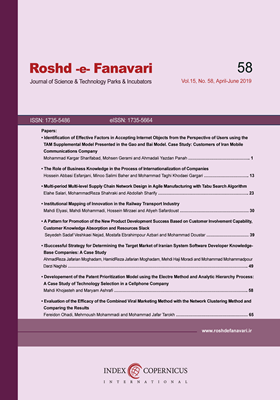Developement of the Patent Prioritization Model using the Electre Method and Analytic Hierarchy Process: A Case Study of Technology Selection in a Cellphone Company
Subject Areas : Technology Transfer and Commercialization of Researchesmehdi khojasteh 1 , Marayam Ashrafi 2 *
1 -
2 -
Abstract :
With the advent of growing knowledge of the economy and the rapid growth of technology, intellectual property has become the focus of attention of corporate investment managers and researchers. Patent are considered to be the most important intellectual asset, and one of the reasons for this is the extensive research that has been done on the various dimensions of these rights. The patent provides the possessor with the possibility to use the technology exclusively for a limited period (often twenty years). Since many industrial and service companies need to acquire new technologies by the purchase of patent rights to maintain their competitive advantage and sustained business growth, the issue of patent assessment has become a serious challenge in the field of technology. In this research, a model for evaluating and ranking patents based on multi-criteria programming methods is presented and then the resulting model is implemented in a cell phone company. The company is required to choose a technology from four technologies: (1) a dual display, (2) missing phone tracking, (3) wireless communications security, and (4) remote banking to develop its products. The implementation of the model is based on four main criteria: (1) the essence of technology, (2) the cost of technology, (3) the product market, and (4) the technology market in the company led to the choice of wireless security technology. Also the accuracy of the result obtained from the implementation of the research model has been confirmed by the method of ELECTRE.
1- قدسیپور، حسن، فرایند تحلیل سلسله مراتبی، دانشگاه صنعتی امیرکبیر، 1395.
2- Corrado, Carol, Charles Hulten, and Daniel Sichel, Intangible capital and US economic growth, Review of income and wealth 55)3), pp. 661-685, 2009.
3- Nakamura, L.I., Intangible assets and national income accounting, Review of Income and Wealth, 56(1), pp.135-155, 2010.
4- Hanel, P., Intellectual property rights business management practices: A survey of the literature, Technovation, 26(8), pp.895-931, 2006.
5- Hsieh, C.H., Patent value assessment and commercialization strategy, Technological Forecasting and Social Change, 80(2), pp.307-319, 2013.
6- Reitzig, M., Improving patent valuations for management purposes—validating new indicators by analyzing application rationales, Research policy, 33(6-7), pp.939-957, 2004.
7- Vega-González, L.R., Qureshi, N., Kolokoltsev, O.V., Ortega-Martínez, R. and Blesa, J.S.,Technology valuation of a scanning probe microscope developed at a university in a developing country, Technovation, 30(9-10), pp.533-539, 2010.
8- Gogan, L.M. and Draghici, A., A model to evaluate the intellectual capital, Procedia Technology, 9, pp.867-875, 2013.
9- What is Intellectual Property, WIPO Publication, 450(E).
10- Vega-González, L.R., Qureshi, N., Kolokoltsev, O.V., Ortega-Martínez, R. and Blesa, J.S., Technology valuation of a scanning probe microscope developed at a university in a developing country, Technovation, 30(9-10), pp.533-539, 2010.
11- Schuh, G., Schubert, J. and Wellensiek, M., Model for the Valuation of a Technology Established in a Manufacturing System, Procedia CIRP, 3, pp.602-607, 2012.
12- Russell, M., 2016. The valuation of pharmaceutical intangibles. Journal of Intellectual Capital, 17(3), pp.484-506.
13- Ernst, H., Legler, S. and Lichtenthaler, U., Determinants of patent value: Insights from a simulation analysis. Technological Forecasting and Social Change, 77(1), pp.1-19, 2010.
14- Hoe, S. and Diltz, J.D., A real options approach to valuing and negotiating licensing agreements, The Quarterly Review of Economics and Finance, 52(3), pp.322-332, 2012.
15- Xiao-yang, Y. and Chang-xin, X., A research on Intellectual Property valuation model under uncertainty, Management Science and Engineering (ICMSE), pp. 469-475, 2013.
16- Van Zee, R.D. and Spinler, S., Real option valuation of public sector R&D investments with a down-and-out barrier option, Technovation, 34(8), pp.477-484, 2014.
17- Ho, W. and Ma, X. The state-of-the-art integrations and applications of the analytic hierarchy process. European Journal of Operational Research, 267(2), pp.399-414, 2018.
18- Dos Santos, P.H., Neves, S.M., Sant’Anna, D.O., de Oliveira, C.H. and Carvalho, H.D. The analytic hierarchy process supporting decision making for sustainable development: An overview of applications. Journal of Cleaner Production, 2018.
19- Long, S., Zhao, L., Liu, H., Li, J., Zhou, X., Liu, Y., Qiao, Z., Zhao, Y. and Yang, Y., 2019. A Monte Carlo-based integrated model to optimize the cost and pollution reduction in wastewater treatment processes in a typical comprehensive industrial park in China. Science of the total environment, 647, pp.1-10.
20- Doumpos, M. and Figueira, J.R., 2019. A multicriteria outranking approach for modeling corporate credit ratings: An application of the Electre Tri-nC method. Omega, 82, pp.166-180.
21- T.L. Saaty, the Analytic Hierarchy Process, McGraw-Hill, New York, 1980.
22- Benayoun, R., Roy, B. and Sussman, N., Manual de reference du programme electre, Note de synthese et Formation, 25, p.79, 1966.
23- Chiu, Y.J. and Chen, Y.W., Using AHP in patent valuation. Mathematical and Computer Modelling, 46(7-8), pp.1054-1062, 2007.
24- Available: https://www.ipofferings.com. [Accessed April 2018]

